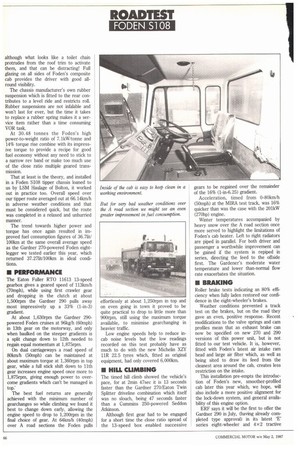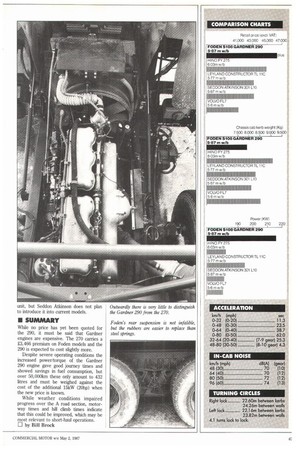IT'S A G AT GARDN
Page 66

Page 67

Page 68

Page 69

If you've noticed an error in this article please click here to report it so we can fix it.
Foden's S108 eight-legger tipper, powered by the latest 12.7 litre Gardner 6LXDT 290 straight six turbocharged diesel, offers a useful mix of power and economy: but top quality doesn't come cheap.
• Two years ago, before being absorbed by the Perkins group, L Gardner and Sons launched the 6LXDT engine. It is a 12.7 litre turbocharged, in-ffhe six-cylinder diesel with direct injection, and is rated at 201kW (270hp).
The 6LXDT was developed from the 10.45 litre 6LXCT unit with a bore up from 120nun to 130nun and stroke leng then m 152nun to 159mm. Gardner's traditional construction, incorporating an aluminium crankcase, results in an exceptionally light engine for its capacity. Weighing only 903kg with all accessories, it is lighter than its Rolls Royce Eagle stablemate at 1,137kg. Its 12.7 litre capacity indicates that it is lighter stressed than competitive engines of almost three litres less — and it is lighter than them, too.
• ENGINE
Over the past 12 months modifications have been made to improve head gasket sealing, and careful matching of fuel and turbocharger characteristics has boosted the power output to 216kW (290hp) without increasing engine speed above 1,900rpm, and without recourse to charge cooling.
More impressive still is the amount of torque produced by the Gardner 290. While peaking at 1,241Nm (9151bft) at 1,350rpm, it maintains over 1,18ONm
(870Ib1t) from 1,000rpm to 1,650rpm to provide exceptional flexibility. The lower figure is almost identical to the peak torque figure quoted for the popular proprietary Cummins LT10 290 power unit, while the Eagle 290 engine's peak torque of 1,220Nm (9001bft) is exceeded between 1,200 and 1, 50Orpm.
III CAB COMFORT
Access to Foden's cab is made easy by three wide steps that give good grip. The interior is certainly functional, with wipeclean surfaces and a floor pan with no lip at the door edge to prevent easy removal of the mud and gravel which inevitably accumulates during a day's work.
A low engine cowl divides the driver and passenger sides, obstructing crosscab access.
In contrast to the stark brown trim and black rubber floor covering, the Isringhausen air suspension seat provides a de gree of opulence. The limited dimensions of the day cab limit rearward movement of the seat, but there is ample adjustment for driver comfort. The instrumentation layout looks a little crude, but the dials and gauges can be seen clearly and all controls are within arm's length.
For those who have not yet encountered the 13-speed range-change splitter transmission the gear sequence may seem a little strange. A crawler gear is located opposite reverse, but from then on a fourposition gate is used with split gears available with the top four ratios.
Air horns mounted on the roof give much louder indication of the vehicle's presence than the standard horns — although what looks like a toilet chain protrudes from the roof trim to activate them, and that can be distracting! Full glazing on all sides of Foden's composite cab provides the driver with good allround visibility.
The chassis manufacturer's own rubber suspension which is fitted to the rear contributes to a level ride and restricts roll. Rubber suspensions are not infalable and won't last for ever, but the time it takes to replace a rubber spring makes it a service item rather than a time consuming VOR task.
At 30.48 tonnes the Foden's high power-to-weight ratio of 7.1kW/tonne and 14% torque rise combine with its impressive torque to provide a recipe for good fuel economy without any need to stick to a narrow rev band or make too much use of the close ratio multiple geared transmission.
That at least is the theory, and installed in a Foden S108 tipper chassis loaned to us by LSM Haulage of Bolton, it worked out in practice too. Overall speed over our tipper route averaged out at 66.14km/h in adverse weather conditions and that must be considered quick, but the route was completed in a relaxed and unhurried manner.
The trend towards higher power and torque has once again resulted in improved fuel consumption figures of 36.7lit/ 1001un at the same overall average speed as the Gardner 270-powered Foden eightlegger we tested earlier this year, which returned 37.27lit/100krn in ideal conditions.
• PERFORMANCE
The Eaton Fuller RTO 11613 13-speed gearbox gives a geared speed of 113km/h (70mph), while using first crawler gear and dropping in the clutch at about 1,500rpm the Gardner 290 pulls away most impressively up a 33% (1-in-3) gradient.
At about 1,630rpm the Gardner 290powered Foden cruises at 96kg/h (60mph) in 13th gear on the motorway, and only when baulked on the steeper gradients is a split change down to 12th needed to regain equal momentum at 1,875rpm.
On dual carriageways a road speed of 80Iorn/h (50mph) can be maintained at about maximum torque at 1,360rpm in top gear, while a full stick shift down to 11th gear increases engine speed once more to 1,875rpm, giving enough power to overcome gradients which can't be managed in top: The best fuel returns are generally achieved with the minimum number of gearchanges so while climbing we found it best to change down early, allowing the engine speed to drop to 1,200rpm in the final choice of gear. At 64km/h (40mph) over A road sections the Foden pulls effortlessly at about 1,250rpm in top and on even going in town it proved to be quite practical to drop to little more than 900rpm, still using the maximum torque available, to minimise gearchanging in heavier traffic.
Low engine speeds help to reduce incab noise levels but the low readings recorded on this test probably have as much to do with the new Michelin XZY 11R 22.5 tyres which, fitted as original equipment, had only covered 6,000km.
• HILL CUMBING
The tined hill climb showed the vehicle's pace, for at 2min 47sec it is 13 seconds faster than the Gardner 270/Eaton Twin Splitter driveline combination which itself was no slouch, being 47 seconds faster than a Cummins 250-powered Seddon Atkinson.
Although first gear had to be engaged for a short time the close ratio spread of the 13-speed box enabled successive gears to be regained over the remainder of the 16% (1-in-6.25) gradient.
Acceleration, timed from 0-80km/h (50mph) at the MIRA test track, was 16% quicker than was the case with the 201kW (270hp) engine.
Winter temperatures accompanied by heavy snow over the A road section once more served to highlight the limitations of Foden's cab heater. Left to right radiators are piped in parallel. For both driver and passenger a worthwhile improvement can be gained if the system is repiped in series, directing the feed to the offside first. The Gardener's moderate water temperature and lower than-normal flow rate exacerbates the situation.
• BRAKING
Roller brake tests indicating an 80% efficiency when fully laden restored our confidence in the eight-wheeler's brakes.
Weather conditions prevented a track test on the brakes, but on the road they gave an even, positive response. Recent modifications to the valve springs and cam profiles mean that an exhaust brake can now be specified on new 270 and 290 versions of this power unit, but is not fitted to our test vehicle. It is, however, fitted with Foden's latest air intake ram head and large air filter which, as well as being sited to draw its feed from the cleanest area around the cab, creates less restriction on the intake.
This installation pre-empts the introduction of Foden's new, smoother-profiled cab later this year which, we hope, will also include a more positive alignment for the lock-down system, and general availability of this engine option.
ERF says it will be the first to offer the Gardner 290 in July, (having already completed type approval) in its latest 'E' series eight-wheeler and 4x 2 tractive
unit, but Seddon Atkinson does not plan to introduce it into current models.
• SUMMARY
While no price has yet been quoted for the 290, it must be said that Gardner engines are expensive. The 270 carries a 23,466 premium on Foden models and the 290 is expected to cost slightly more.
Despite severe operating conditions the increased power/torque of the Gardner 290 engine gave good journey times and showed savings in fuel consumption, but over 50,000km these only amount to 432 litres and must be weighed against the cost of the additional 15kW (20hp) when the new price is known.
While weather conditions impaired progress over the A road section, motorway times and hill climb times indicate that this could be improved, which may be most relevant to short-haul operations. 0 by Bill Brock




























































































































